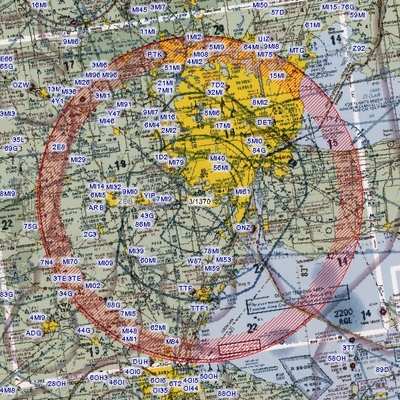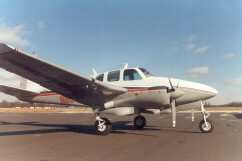They Keep Popping Up When You Least Expect Them!
By Richard I. Ward, President, Twin Bonanza Association
While filing an IFR flight plan for a fairly distant trip from
my home base in Three Rivers (MI) in T-Bone N800EX, the Lansing FSS
fellow asked me if I had checked on the current Temporary Flight
Restricted areas (TFRs) on my route. My response was (I wonder what
yours would be) "No! I never do that as long as I'm on an IFR
flight plan, nor do I file around restricted areas when filing a
direct to clearance." His following comeback was emphatic "Having
you avoid these areas is in no way the legal responsibility of Air
Traffic Control, and it is your complete responsibility."

Wow, That was a revelation and I momentarily went into an argue
mode, then backed off rapidly when I envisioned a brick wall being
constructed before my very eyes. Not only that, but I was getting
demoralized by a more important factor: Having to put up with the
Michigan winter too much longer, while there was sunshine in view
at the end of our planned trip. The FSS fellow accepted my flight
plan and shortly thereafter freed ourselves from the bonds of
earth.
Well let's see now I was proven wrong on a point that I argued
about 25 or so years ago, and it's just possible that I could be
wrong on this argument. I later decided to contact the AOPA and
give them the opportunity to research this subject. To their credit
they sent my email out to the appropriate party at the FAA Here was
their response:
 Hello Mr. Ward,
Hello Mr. Ward,
Your email was forwarded to us here in the Air Traffic
department of AOPA. I contacted FAA headquarters for an official
response to your question and received the following
explanation: Guess you could say it is the responsibility of
both the pilot and air traffic controller:
FAA Order 7110.65 states that ATC shall vector aircraft for
separation and safety. This includes vectoring aircraft around TFRs
as well as traffic. For the pilot, the applicable regulation is 14
CFR 91.103 which pertains to preflight action and states that "Each
pilot in command shall, before beginning a flight, become familiar
with all available information concerning that flight," which
includes TFRs. Additional regulations are covered in 14 CFR 91.13
and whichever CFR promulgated the TFR (e.g. 14 CFR 91.137; 14 CFR
91.138; 14 CFR 91.139; 14 CFR 91.141; 14 CFR 91.143; 14 CFR
91.145)
From a legal standpoint TFR avoidance is a joint responsibility.
(This is in no way to be construed as a legal interpretation from
FAA's legal staff). A pilot should not file an IFR flight through a
TFR. If they did and that flight violated the TFR, they are subject
to enforcement action.
From an Air Traffic Quality Assurance standpoint, a controller
should not allow an IFR or VFR flight that they are working to fly
though a TFR. If they did, they would be subject to an Operational
Deviation. However, looking at the totality of the circumstances:
It is the pilot-in-command's (PIC's) duty to know exactly where the
airspace is, just as it is ATC's responsibility to know where the
airspace is. If ATC gave the pilot a vector that was going to take
the aircraft right into the TFR and the pilot did not question the
controller (just as if s/he would if being vectored into an area of
known thunderstorms) then it is still the final responsibility of
the pilot to question the clearance, just as it would be ATC's
responsibility to question a pilot who wanted to fly directly
through a TFR. Luckily, we are not aware of any instance where a
controller let an IFR aircraft fly into a TFR. However, we are
aware of many cases where pilots filed flights directly through
TFRs and thought that ATC would vector them around, but instead,
the pilot departed VFR expecting to pick up an IFR clearance in the
air. While waiting for ATC to respond and issue a clearance the
pilot flew through the TFR. In those cases, FAA suspended pilot
certificates from 30 to 150 days.
 There is no question that it is bad
operating practice to file an IFR flight through a TFR. During
flight planning, pilots should avoid TFRs. Arguably, to
deliberately file a flight plan through a known TFR, in and of
itself, would be a violation of 14 CFR 91.103.
There is no question that it is bad
operating practice to file an IFR flight through a TFR. During
flight planning, pilots should avoid TFRs. Arguably, to
deliberately file a flight plan through a known TFR, in and of
itself, would be a violation of 14 CFR 91.103.
Hope this helps!
Heidi J. Williams
Manager
Air Traffic, Regulatory & Certification Policy
Draw your own conclusions. I guess the only positive bit of news
in the waffling back and forth statement above is that I was not
right in my argument, but by golly, neither was I wrong. So there!
In the meantime, I'll take a peek at the TFRs, but won't admit it
to the FSS controller, when I call Lansing.
 Aero-News: Quote of the Day (10.27.25)
Aero-News: Quote of the Day (10.27.25) ANN's Daily Aero-Linx (10.27.25)
ANN's Daily Aero-Linx (10.27.25) NTSB Prelim: Lancair 320
NTSB Prelim: Lancair 320 Airborne Programming Continues Serving SportAv With 'Airborne-Affordable Flyers'
Airborne Programming Continues Serving SportAv With 'Airborne-Affordable Flyers' Airborne-Flight Training 10.23.25: PanAm Back?, Spirit Cuts, Affordable Expo
Airborne-Flight Training 10.23.25: PanAm Back?, Spirit Cuts, Affordable Expo





